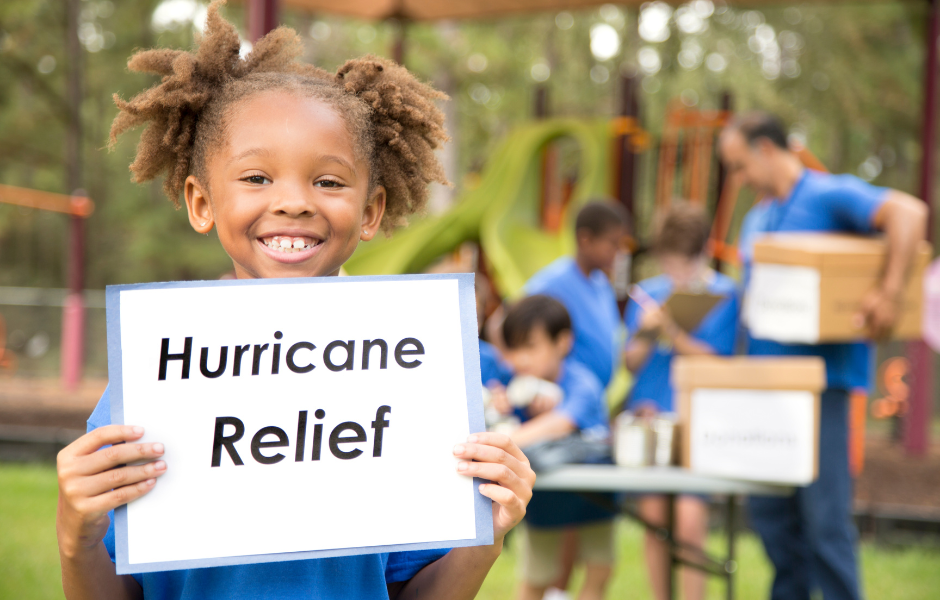As families in the Southeast are beginning the long recovery from hurricanes Helene and Milton, they will also have to make healing from the mental and emotional trauma a priority. Many children witnessed and experienced something terrifying. Some had their lives turned upside down, they lost loved or their homes and belongings.
How do they move on?
Exposure to trauma makes children feel frightened and helpless, and they need calm, caring and consistent caregivers. Remaining calm when they are agitated and teaching calming techniques reduces the anxiety and emotional arousal that affects their mood, behavior, sleep, and concentration. Open and honest communication about loss and feelings are key while taking positive action, like involving your child in recovery and service efforts will help them feel empowered in their healing.
Here we share some strategies for building resilience after a traumatic experience, whether it is a natural disaster or other event.
Healing emotional wounds
The following are strategies for parents who want to help their children mend emotional wounds:
• Talk with your child: Communication builds trust and is a constructive coping skill; find times they are likely to talk; start the conversation; let them know you are interested.
• Listen: Listen to their thoughts, feelings, and points of view with empathy; don’t interrupt, judge, or criticize; listening opens the door to a trusting relationship.
• Accept feelings: Anxiety, irritability, anger, and depression are normal reactions to loss and trauma and will subside over time in a safe environment.
• Be patient and supportive: It takes time to come to terms with trauma and grieve losses; each child’s path to recovery is unique; offer comfort and reassurance; be available when they are ready.
• Encourage healthy expression: Children act out distress negatively without constructive outlets; foster the use of art, play, music, sports, journaling, and other healthy forms of expression.
• Maintain consistency: Structure and routines enhance security and stability; provide appropriate rules, expectations, boundaries, and consequences.
• Promote a sense of control: Children feel helpless and powerless in response to trauma; help them believe they can successfully deal with challenges via constructive activities (e.g., hobbies, sports, clubs,
volunteering).
• Make home a safe place: Your home should be a “safe haven,” a place of comfort, security and peace; stress and chaos provoke traumatic reactions; minimize conflict and give discipline with calmness and love.
• Foster new beliefs: Children develop negative beliefs about themselves and others when traumatized; offer “listening time” to give children a chance to share feelings, problem-solve, establish trust and create positive beliefs.
• Be honest: Children make up their own stories if adults don’t help them understand the truth; honesty is essential, but keep in mind their age and emotional ability; avoid details that could re-traumatize them.
• Help with trauma stories: Children are asking for help when they tell their stories; listen, be supportive, help them “make sense” of what happened; send the message that it was not their fault, and help them understand their feelings.
• Don’t take it personally: Children can “push your buttons;” you are less likely to be angry or anxious if you know your own emotional triggers—then you can remain calm and respond in a helpful way.
• Focus on the positive: Acknowledge and praise positive behavior; “catch your child doing something right;” have fun, laugh—humor reduces tension and creates connection; playing is a great way to bond.
• Limit media: TV, movies, and video games may be frightening and over-stimulating; monitor and supervise media based on your child’s emotional needs and reactions.
• Be aware of body language: Your tone of voice, facial expressions, and body language communicate more than your words; show via body language that you are safe, understanding, and supportive.
• Maintain perspective: You can’t change the fact that tragic events happened, but you can change how you interpret and respond to those events; help children accept what can’t be changed and focus on things that can be changed.
• Have an “opportunity mindset:” People often grow following tragedy and hardship: better relationships, self-worth, inner strength, spirituality, and appreciation for life; help children use their experiences to learn and grow.
• Inspire a sense of belonging: Being a part of a family and community enhances children’s security, identity and loyalty; traditions and rituals increase their sense of belonging (e.g., celebrating birthdays, holidays, cultural customs and practices).
• Volunteer as a family: Charitable actions turn pain into something positive, create a sense of purpose and control (“I can make a difference”), which leads to reclaiming hope; assisting others also benefits the helper.
• Avoid labels: Labeling a child can have negative consequences; the child labeled as “difficult” can develop a reputation that follows him or her everywhere; when children see themselves as bad they act bad.
• Take care of yourself: Stay healthy so that you can take care of your children; be a good role model of self-care and stress management—eat well, exercise, get plenty of rest and support, avoid alcohol and drugs, do yoga, meditation, and spiritual practices; surround yourself with loving and supportive friends and family.


